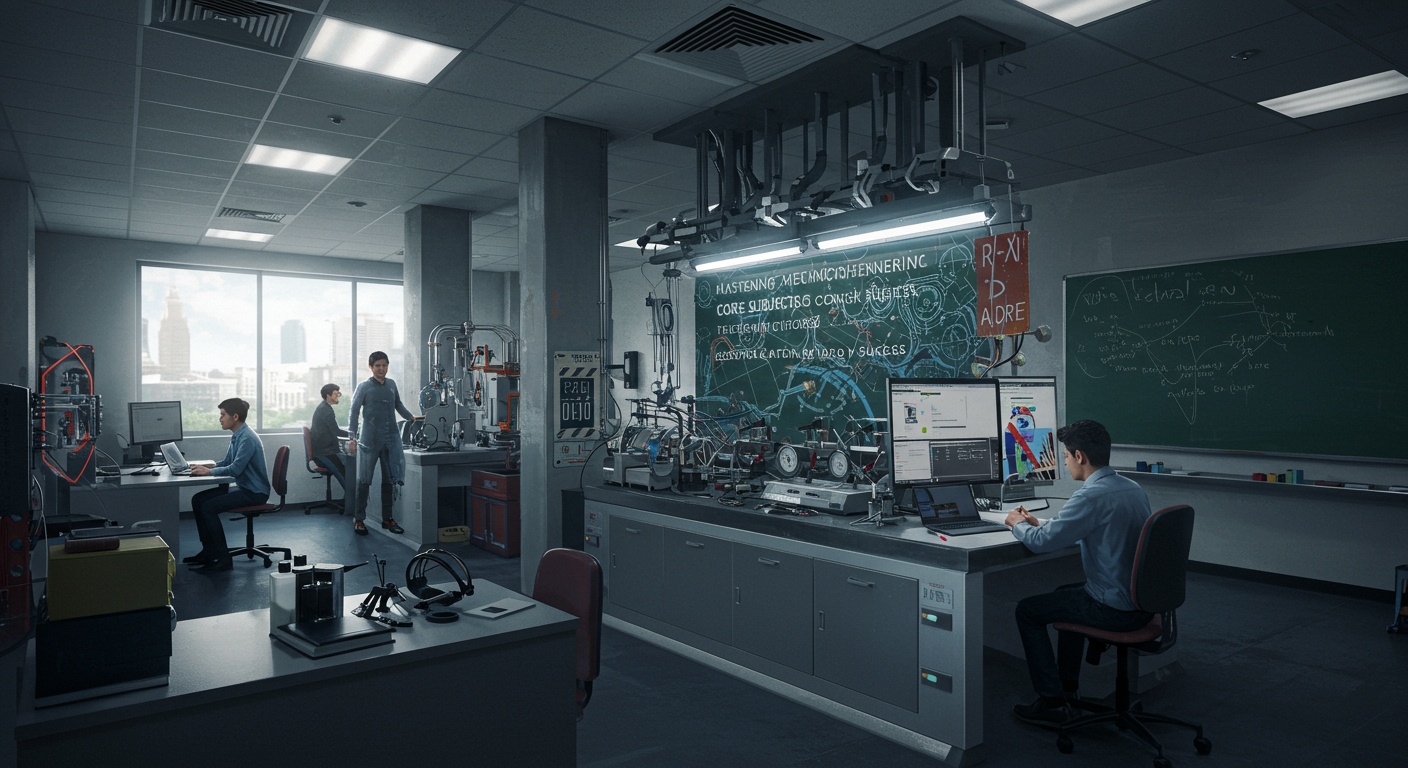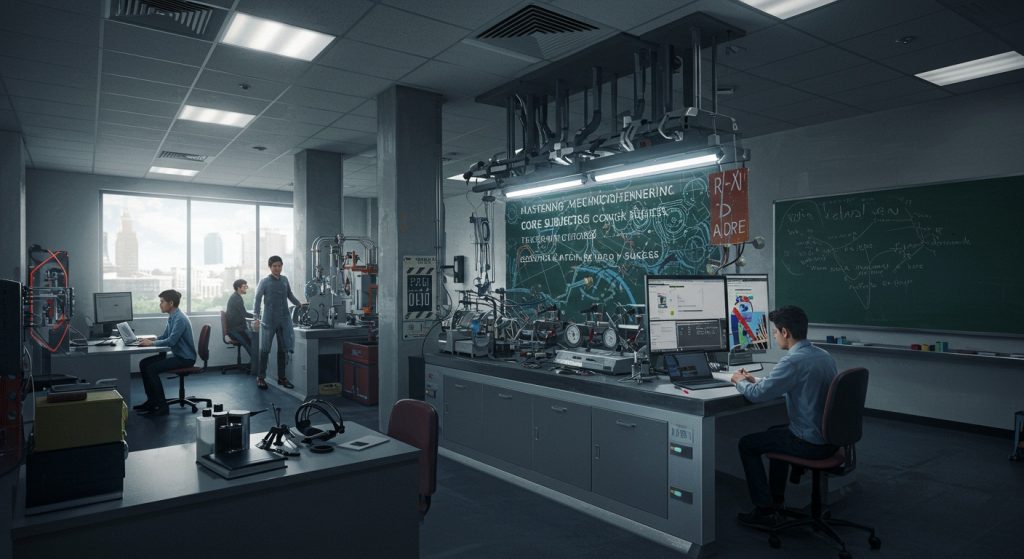The GATE examination critically evaluates a candidate’s profound understanding of mechanical engineering core subjects, moving beyond mere memorization to assess foundational principles crucial for modern innovation. Grasping concepts like the thermodynamics behind advanced power cycles, or the fluid mechanics governing efficient drone propulsion in urban air mobility, prepares aspirants for real-world engineering challenges. Similarly, mastering machine design principles proves essential for developing robust robotic systems in smart manufacturing, while solid mechanics knowledge becomes vital for optimizing stress distribution in additively manufactured aerospace components. This comprehensive focus on core subjects, from heat transfer to manufacturing processes, equips future engineers to leverage recent developments like digital twin technology for predictive maintenance and generative design in complex systems, securing GATE success and a path to impactful careers.

Understanding the Foundation: Engineering Mechanics
Engineering Mechanics forms the bedrock of mechanical engineering, providing the fundamental principles for analyzing forces and motion. For anyone preparing for the GATE exam, a strong grasp of this subject is non-negotiable. It’s not just about memorizing formulas; it’s about understanding the “why” behind every structural design or machine movement. This foundational knowledge is crucial for a comprehensive GATE Exam tutorial for Mechanical Engineering core subjects.
Key Concepts and GATE Relevance:
- Statics: Deals with bodies at rest or in constant velocity. Key topics include equilibrium of particles and rigid bodies, analysis of trusses and frames, friction. Centroids & moment of inertia. Understanding how to draw accurate free-body diagrams (FBDs) is paramount here.
- Dynamics: Focuses on bodies in motion. This branches into kinematics (describing motion without considering forces) and kinetics (analyzing forces causing motion). Concepts like Newton’s laws of motion, work-energy principles, impulse-momentum. Vibrations are frequently tested.
Real-world Application:
Consider the design of a bridge: Statics is used to ensure the bridge can withstand the static loads (its own weight, vehicles at rest) without collapsing. Dynamics comes into play when analyzing the impact of moving vehicles or the bridge’s response to wind gusts and seismic activity. Similarly, in robotics, understanding the dynamics of manipulators is essential for precise movement and control.
Actionable Takeaways for GATE:
- Practice drawing clear Free Body Diagrams (FBDs) for every problem. This is the single most crucial skill.
- Master the concept of moment of inertia, as it reappears in Strength of Materials and Machine Design.
- For dynamics, differentiate clearly between linear and angular motion concepts.
- A good GATE Exam tutorial for Mechanical Engineering core subjects will emphasize solving a variety of problems, from simple particle equilibrium to complex multi-body systems.
Diving Deep: Strength of Materials (Mechanics of Materials)
Where Engineering Mechanics deals with rigid bodies, Strength of Materials (SOM) delves into the behavior of deformable bodies under various loads. It’s about understanding how materials respond to stress and strain, making it a critical subject for designing safe and efficient structures and machine components. This is a vital part of any GATE Exam tutorial for Mechanical Engineering core subjects, as it directly relates to material failure and design.
Core Principles:
- Stress and Strain: Normal stress, shear stress, volumetric strain, Poisson’s ratio. Understanding Hooke’s Law and the stress-strain curve for different materials (ductile vs. Brittle) is fundamental.
- Axial Loading: Deformation of bars, thermal stresses.
- Shear Force and Bending Moment Diagrams (SFD & BMD): Essential for analyzing beams under transverse loads. The relationship between load, shear force. Bending moment is crucial.
- Torsion: Twisting of circular shafts, angle of twist, shear stress distribution.
- Bending Stresses: Flexural formula, section modulus, moment of inertia application.
- Transformation of Stress and Strain: Mohr’s Circle is a key tool here for finding principal stresses and maximum shear stress.
- Deflection of Beams: Various methods like double integration, Macaulay’s method, moment-area method. Superposition.
- Columns: Euler’s buckling theory and Rankine’s formula.
Real-world Application:
When designing an aircraft wing, engineers use SOM principles to calculate the stresses induced by lift and drag forces, ensuring the wing material can withstand these without permanent deformation or fracture. Similarly, the thickness and material of a pressure vessel are determined using SOM to contain high-pressure fluids safely. My colleague, a structural engineer, once recounted how a slight miscalculation in bending moment for a steel beam led to significant sagging, requiring costly reinforcement—a direct consequence of inadequate SOM application.
Actionable Takeaways for GATE:
- Memorize and grasp the assumptions behind each formula (e. G. , Euler’s column formula assumes pin-ended columns).
- Practice drawing SFD and BMDs for various loading conditions.
- Master Mohr’s Circle for stress and strain transformations.
- Pay attention to units and sign conventions, especially for shear force and bending moment.
The Flow of Knowledge: Fluid Mechanics
Fluid Mechanics is the study of fluids (liquids and gases) at rest and in motion. It’s a vast and fascinating subject with applications ranging from aerospace to biomedical engineering. For the GATE exam, this topic is consistently high-scoring, requiring a conceptual understanding as well as problem-solving skills.
Key Areas of Study:
- Fluid Properties: Density, viscosity (kinematic and dynamic), surface tension, capillarity, compressibility.
- Fluid Statics: Pressure and its measurement, hydrostatic forces on submerged surfaces (plane and curved), buoyancy. Flotation. Pascal’s Law and Archimedes’ Principle are fundamental.
- Fluid Kinematics: Types of flow (laminar, turbulent, steady, unsteady, uniform, non-uniform), stream function, velocity potential function, continuity equation.
- Fluid Dynamics: Bernoulli’s equation, momentum equation, Euler’s equation, Navier-Stokes equations (conceptual understanding), flow through pipes (major and minor losses), boundary layer theory, dimensional analysis. Similitude.
Real-world Application:
Think about how a submarine submerges and surfaces – that’s buoyancy in action. Or how a car’s aerodynamic design reduces drag – that’s fluid dynamics. In power plants, the design of pipelines and pumps relies heavily on understanding fluid flow, pressure losses. Efficiency. A recent project I consulted on involved optimizing a water distribution network; applying principles of pipe flow and pressure drop calculation directly led to significant energy savings for the municipality.
Actionable Takeaways for GATE:
- Clearly distinguish between static and dynamic fluid concepts.
- Practice problems involving manometers and hydrostatic forces.
- grasp the assumptions and limitations of Bernoulli’s equation.
- For pipe flow, remember the Darcy-Weisbach equation and minor loss coefficients.
- This GATE Exam tutorial for Mechanical Engineering core subjects emphasizes solving numerical problems with practical application.
Heat Transfer: Understanding Energy Movement
Heat Transfer is the study of thermal energy movement between physical systems. It’s crucial for designing efficient heating, ventilation. Air conditioning (HVAC) systems, heat exchangers, engines. Electronic cooling systems. This subject often appears in conjunction with Thermodynamics in the GATE exam.
Modes of Heat Transfer:
- Conduction: Heat transfer through direct contact, governed by Fourier’s Law. Concepts include thermal conductivity, thermal resistance, composite walls. Extended surfaces (fins).
- Convection: Heat transfer through fluid motion. This can be forced (e. G. , fan) or natural (buoyancy-driven). Key concepts include Nusselt number, Prandtl number. Reynolds number. Understanding boundary layers.
- Radiation: Heat transfer through electromagnetic waves. Stefan-Boltzmann Law, Wien’s Displacement Law, blackbody radiation, view factors. Radiation shields are essential.
Comparing Heat Transfer Modes:
| Feature | Conduction | Convection | Radiation |
|---|---|---|---|
| Mechanism | Molecular vibration/electron movement | Fluid movement (bulk motion) | Electromagnetic waves |
| Medium Required | Yes (solid, liquid, gas) | Yes (fluid) | No (can occur in vacuum) |
| Examples | Heat through a metal rod, insulation | Boiling water, CPU cooling fan | Sun’s heat, thermal imaging |
| Governing Law(s) | Fourier’s Law | Newton’s Law of Cooling (empirical), Navier-Stokes (for fluid flow) | Stefan-Boltzmann Law |
Real-world Application:
Every time you use a refrigerator, you’re experiencing principles of heat transfer and thermodynamics. The condenser coils release heat to the surroundings (convection and radiation), while the evaporator coils absorb heat from inside (convection). In a power plant, the design of boilers and condensers is entirely based on optimizing heat transfer to maximize efficiency. I once worked on a project to design a cooling system for high-power lasers, where precise control over all three modes of heat transfer was essential to prevent overheating and ensure stable operation.
Actionable Takeaways for GATE:
- interpret the concept of thermal resistance and its electrical analogy.
- Be proficient in solving problems involving heat exchangers (LMTD and effectiveness-NTU methods).
- For radiation, remember the concept of emissivities and view factors.
- A good GATE Exam tutorial for Mechanical Engineering core subjects will cover problems integrating all three modes of heat transfer.
The Science of Energy: Thermodynamics
Thermodynamics is the study of energy and its transformations. It’s the backbone of power generation, refrigeration. Many industrial processes. For the GATE exam, this subject requires a strong conceptual understanding of fundamental laws and their application to various systems and cycles.
Fundamental Laws and Concepts:
- Zeroth Law: Defines thermal equilibrium and temperature.
- First Law (Conservation of Energy): For closed systems (
ΔU = Q - W) and open systems (steady flow energy equation, SFEE). Understanding enthalpy and internal energy.
- Second Law: Deals with the direction of energy transfer and the concept of entropy. Kelvin-Planck and Clausius statements, Carnot cycle. Irreversible processes.
- Third Law: Defines absolute zero entropy.
- Properties of Pure Substances: Phase changes, P-V-T diagrams, property tables (steam tables), Mollier chart.
- Thermodynamic Cycles: Power cycles (Rankine, Brayton, Otto, Diesel), refrigeration cycles (Vapor Compression Refrigeration – VCR). Understanding efficiency and Coefficient of Performance (COP).
Real-world Application:
Every internal combustion engine in a car operates on thermodynamic principles (Otto or Diesel cycle). Power plants, whether thermal or nuclear, rely on the Rankine cycle to convert heat into electricity. Even your air conditioner works based on the VCR cycle. I recall a factory audit where optimizing the steam cycle in their cogeneration plant, using thermodynamic principles, led to a 15% improvement in overall energy efficiency—a testament to the practical power of this subject.
Actionable Takeaways for GATE:
- Master the First Law of Thermodynamics for both open and closed systems.
- interpret the concept of entropy and its implications for reversibility and irreversibility.
- Be proficient in using steam tables and Mollier charts.
- Practice solving problems for various thermodynamic cycles, calculating efficiencies and COPs.
- A solid GATE Exam tutorial for Mechanical Engineering core subjects will dedicate significant time to cycle analysis.
Shaping the Future: Manufacturing Engineering
Manufacturing Engineering is concerned with the processes of converting raw materials into finished products. It bridges the gap between design and production, encompassing a wide array of techniques and technologies. This subject is crucial for understanding industrial processes and is a significant part of the GATE syllabus.
Broad Categories:
- Material Science: Properties of engineering materials (metals, ceramics, polymers, composites), phase diagrams, heat treatment.
- Casting: Sand casting, die casting, investment casting, centrifugal casting. Defects and remedies.
- Forming Processes: Rolling, forging, extrusion, drawing, sheet metal operations (bending, drawing, shearing).
- Machining Processes: Lathe, milling, drilling, grinding. Machining parameters (cutting speed, feed, depth of cut), tool materials, tool wear, economics of machining.
- Joining Processes: Welding (arc, gas, resistance, special welding processes), brazing, soldering, adhesive bonding.
- Powder Metallurgy: Compaction, sintering.
- Metrology & Inspection: Linear and angular measurements, limits, fits and tolerances, gauges.
- Non-Traditional Machining Processes (NTMM): EDM, ECM, LBM, AJM, USM.
- Additive Manufacturing (3D Printing): FDM, SLA, SLS.
Real-world Application:
From the car you drive to the smartphone in your hand, every manufactured product is a result of applying these principles. The engine block is typically cast, the car body panels are formed. Critical components are machined to high precision. Even the plastic casing of your phone is likely injection molded. I once visited a factory that manufactured precision medical instruments; observing their advanced machining centers and stringent quality control (metrology) truly highlighted the importance of mastering these subjects. The choice between a welding process (like TIG vs. MIG) for a specific application often depends on material, cost. Desired joint quality—decisions rooted in manufacturing knowledge.
Actionable Takeaways for GATE:
- grasp the advantages, disadvantages. Typical applications of each manufacturing process.
- For machining, memorize the formulas for material removal rate, tool life. Power consumption.
- Be aware of common defects in casting and welding. Their causes.
- Familiarize yourself with the principles behind non-traditional machining processes.
- A comprehensive GATE Exam tutorial for Mechanical Engineering core subjects will provide detailed comparative analysis of manufacturing techniques.
The Art of Design: Machine Design
Machine Design is the application of all the fundamental mechanical engineering subjects (SOM, Engineering Mechanics, Manufacturing) to create functional and safe mechanical components and systems. It’s where theory meets practice, focusing on selecting appropriate materials, dimensions. Manufacturing processes to meet specific performance requirements.
Key Design Elements:
- Static and Fatigue Loading: Design against static failure (yielding, fracture) and fatigue failure (endurance limit, S-N curve, Soderberg, Goodman, Gerber criteria).
- Design of Joints: Riveted joints, welded joints, bolted joints (eccentric loading).
- Design of Shafts: Torsional and bending loads, critical speed.
- Design of Power Transmitting Elements: Gears (spur, helical, bevel, worm), bearings (journal, rolling contact), clutches, brakes, belts, ropes.
- Design of Springs: Helical, leaf, torsion springs.
- Fluctuating Stresses: Stress concentration factors, notch sensitivity.
Real-world Application:
When an engineer designs a gearbox for a wind turbine, they must consider the immense forces involved, the material properties, the manufacturing feasibility. The expected lifespan. This involves calculating stresses on gears and shafts, selecting appropriate bearings to handle radial and thrust loads. Ensuring the housing can withstand the reaction forces. Every component must be designed to prevent failure under various operating conditions. A personal experience involved reverse-engineering a faulty industrial mixer; the initial design had overlooked fatigue loading on a key shaft, leading to repeated failures. Redesigning it with proper fatigue analysis drastically improved its reliability.
Actionable Takeaways for GATE:
- Clearly distinguish between static and fatigue failure criteria.
- interpret the different types of stresses (normal, shear) and how they combine.
- Be proficient in selecting appropriate materials based on application requirements (strength, stiffness, corrosion resistance, etc.) .
- Practice problems involving the design of shafts, gears. Bolted/welded joints.
- A practical GATE Exam tutorial for Mechanical Engineering core subjects will often integrate problems that require knowledge from multiple subjects, simulating real-world design challenges.
Conclusion
Mastering the core subjects for the GATE exam isn’t merely about memorizing formulas; it’s about cultivating a deep conceptual understanding that fuels true engineering prowess. To truly excel, don’t just passively read about fluid mechanics; actively sketch flow patterns or visualize the energy transfer in a heat exchanger. For instance, understanding Navier-Stokes equations goes beyond their mathematical form when you consider their application in modern computational fluid dynamics (CFD) software, which is increasingly integral to product development, from optimizing drone aerodynamics to designing more efficient HVAC systems. My personal tip for success stems from experience: dedicate significant time to diverse problem-solving. Don’t shy away from numerical problems that require applying concepts from thermodynamics and machine design simultaneously. This cross-pollination of ideas, much like how generative design tools now leverage AI to rapidly explore thousands of design iterations, strengthens your intuition and prepares you for complex, integrated questions. Consistent revision, focusing on your weakest areas, is paramount. Perhaps you find manufacturing processes challenging; instead of just re-reading, watch a few industry videos to visualize the operations. Ultimately, your journey through these GATE tutorials is more than an exam preparation; it’s a foundational step towards becoming a versatile mechanical engineer ready for industry’s challenges. Embrace the learning process, remain persistent. Know that every concept you truly grasp brings you closer to not just a high GATE score. A successful and innovative career.
More Articles
Charting Your Future: Top Biotechnology Career Paths and Earning Potentials
Beyond the Bench: Diverse Roles and Lucrative Salaries in Biotech Innovation
Unveiling Biotechnology: A Simple Guide to What It Is and Why It Matters
Discovering Premier Finance Universities in the UK to Excel in Global Markets
Your Essential Guide to Top Architecture Universities in the UK for Innovators
FAQs
What’s this ‘Mastering Mechanical Engineering Core Subjects’ all about?
It’s a comprehensive collection of tutorials specifically designed to help you truly grasp and master the fundamental concepts across all key mechanical engineering subjects. Think of it as your ultimate guide to building a super strong foundation.
Who should use these tutorials? Are they just for GATE aspirants?
While these tutorials are absolutely essential for anyone preparing for the GATE exam in Mechanical Engineering, they’re also incredibly valuable for any mechanical engineering student looking to deepen their understanding of core subjects, whether for university exams or general knowledge.
What specific mechanical engineering subjects are covered?
We dive deep into all the critical areas like Thermodynamics, Fluid Mechanics, Strength of Materials, Theory of Machines, Machine Design, Heat Transfer, Industrial Engineering. Manufacturing Processes. , all the big ones you need to ace!
How exactly do these tutorials help me ace the GATE exam?
These tutorials are specifically structured with the GATE syllabus in mind. They break down complex topics, provide clear explanations. Include plenty of examples and practice problems to help you apply what you learn, which is key for GATE success.
Is this just theoretical content, or does it include problem-solving?
Definitely not just theory! We put a strong emphasis on practical application. Each subject includes numerous solved examples and practice questions, often mirroring the type of problems you’d encounter in the GATE exam, to ensure you can confidently tackle them.
I’m struggling with a particular subject, say, Thermodynamics. Will this help me improve there?
Absolutely! The tutorials are designed to be accessible, even if you’re starting from scratch or have struggled with a subject before. They build concepts step-by-step, making it easier to grasp even the trickier topics and boost your confidence.
What makes these tutorials ‘essential’ for GATE success?
They’re essential because they provide a focused, in-depth. Exam-oriented approach to mastering the core subjects. We don’t just teach you the concepts; we show you how to apply them to solve GATE-level problems efficiently, which is crucial for scoring well.



